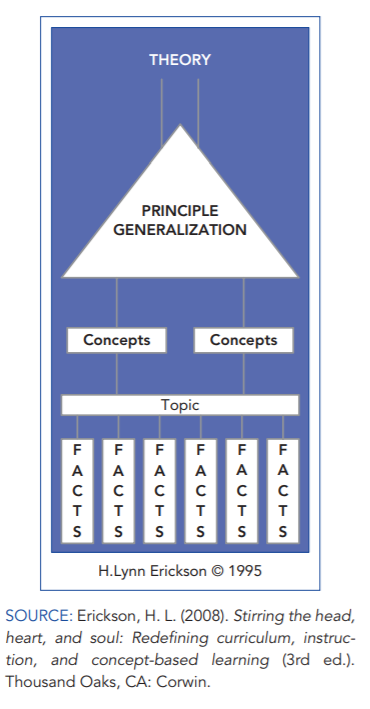H. Lynn Erickson has developed a model for the structure of knowledge where multiple facts fit inside a topic. From the topic, at least one larger concept arises. Then, from the concepts, a broad, generalizable principal can be found. From this principle, one can create an accurate theory.
There are researchers who refer to both facts and concepts as knowledge, but Erickson finds it to be helpful to separate factual knowledge from conceptual understanding. The basic idea being that there are different types of knowledge. This would seem to make sense to me after all, we already distinguish between declarative and procedural knowledge. I also like that the foundation to Erickson’s model is facts. I feel strongly that knowing facts (memorization) is incredibly important for students to actually learn and apply concepts. So, while some researchers may quibble over certain definitions, I do like the diagram and find it to be useful.
 The next step is to understand each stage in the framework of knowledge.
The next step is to understand each stage in the framework of knowledge.
Facts: statements that are true
Topics: collections of related facts
Concepts: mental abstracts that are abstract, timeless, and universal (Erickson & Lanning, 2014, p.33)
Principle Generalization: The relationship between 2 or more concepts (conceptual relationships)
The goal of Erickson’s structure of learning is to make explicit the goal of concept based teaching, transfer. All teachers want students to apply what they are learning to their lives. Doing so inevitably involves some amount of transfer. The basic idea behind concept based teaching is that facts and topics, in and of themselves are non transferable, but concepts are.
Whenever we apply our knowledge from one situation to another, we are always abstracting to a conceptual level. We are taking specific knowledge and generalizing into a broader form until it fits the new situation.
It is important to note, facts are important. You cannot get to the conceptual level if you lack facts. If you lack facts, you do not have any content to generalize or transfer. So, you must have facts, and you must teach facts. But you must not stop at a “fact” level. Go beyond facts. Have students apply them and generalize.
In my next post I will explore how we can teach for conceptual understanding. I am still unsure about teaching for “conceptual understanding” as I mentioned in my last post because it seems to be creating new, unnecessary vocabulary. That said, I am all for its aims. I want my students to know stuff and be able to apply it to a wide variety of circumstances. The more I read, the more positive towards concept based teaching I am becoming.
The content for this post was largely from a free chapter in the book, “Tools for Teaching Conceptual Understanding, Secondary: Designing Lessons and Assessments for Deep Learning“
